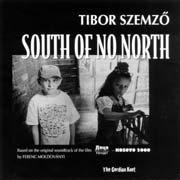
[CD rendelés]
|
|
|
South Of No North - MP3 extract
(Right click > Save target as...)
|
|
1' 55''
|
|
|
|
1. South Of No North
2. Beuys
3. 17
4. Like Kaylash
5. Edmond & Valdrim
6. The Poppy One
7. J.A.S.
8. Gilt Edge
9. Space
10. On The Sly
Total duration
MPEG
video track for PC and MAC:
The
Old House |
|
7'10"
4'23"
6'57"
5'23"
4'21"
6'47"
5'17"
4'50"
5'34"
4'42"
55'28"
3'48""
|
Music
played by the Gordian Knot Company:
Ernst
Hirschberg – keyboards, samplers
Ildi Fodor – female voice, violin (9)
Laca Kéringer – voice, violin (10)
Mihály Huszár – acoustic and electric bass
Kinga Székely – prepared piano
Tibor Szemző – voice, 8mm-phone, flutes
Alois Samson – reeds, sax
Éva Posvanecz – viola, violin, voice
Péter Magyar Összekötő – drums, percussion
The
voices of children and adults – Kosovo 2000
all
music composed by Tibor Szemző c&p BIEM/Artisjus 2001/2003
music
recorded and mixed at ZAK Studio and Pódium Studio, Budapest, HSB
Studio, Dunakeszi from October 2-16, 2000 by Zoltán Regenye
mastered at Gayan Utteyak Mandal, Nagykovácsi from October 30-31 and
November 1, 2002
by László Hortobágyi
Producer:
Attila Bognár
Executive Producer: Leo Feigin
Graphic design: Dezső Kiss
SZEMZŐMUSIC
Once,
dropping into the Mirage sound studio, I was met with an unforgettable
image: on the far side of the studio, in the acoustic aquarium beyond
the glass wall, Szemző was just pressing a palm-sized pocket-radio
to his ear, twisting its tuner: he searched about in the ethereal
chaos with rapt attention. From time to time, chancing upon a suitable
station, he desisted with this, and he slowly waved the device a few
times before the microphone. Following the consummation of the appropriate
movements, he once again pressed the sound source to his ear and continued
his search. Music was just being made. The work, of course, was not
exhausted with this operation; alongside played his earlier recorded
“pure” musical measures, and the ambient, swirling overtones were
placed onto this, portioned out painstakingly.
This
image offers an inside view, not only into the region of sources of
Szemző’s compositions, but faithfully shows his artistic approach,
as well, which reacts to the sounds and traditions of the environment,
the “backdrop” in the broadest sense of the word. At the same time,
he does not allow for contextual pressure; he does not submit himself
to the requirements of the medium, the genre; he lives freely with
them and creatively adapts them as the threads of his own hand-woven
soundscapes.
This gesture of selection and hybridisation involves concrete sounds,
ambient noises and textual fragments, as well as the diverse musical
traditions and spiritual influences apparent in his works. The proportion
of intended and incidental elements in his pieces is indebted exactly
to this, in just the same way as the evolution of the relationship
between the author’s intention and the performer’s freedom. The situations
developed and the instructions given to the musicians during recording
aspire toward the elimination of conventions established in the various
musical spheres of pop and high culture. Thus the performers, rather
than pursuing the well-trodden course, are encouraged to seek uncommon
solutions - and upon hearing the results, it would appear that they
have seized these opportunities. They sound voices of never existing
tonal universes, or sometimes, by way of the silences setting in,
they conjure up vistas reaching into infinity, which nevertheless
feel familiar. Timbres and nuances, common and personal images of
the recent past oscillate in the captivating chain of their tonal
colours. In an incredible density, the yesterdays saturated with suffering
and bliss, rippled with pain, dissolve over them.
J. A. Tillmann





